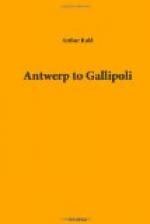East Of Lemberg—Through Austria-Hungary to the Galician Front
We left Nagybiesce in the evening, climbed that night through the high Tatras, stopped in the morning at Kaschau long enough for coffee and a sight of the old cathedral, rolled on down through the country of robber barons’ castles and Tokay wine, and came at length, in the evening, to Munkacs and the foot of the high Carpathians.
This was close to the southernmost point the Russians touched when they came pouring down through the Carpathian passes, and one of the places in the long line where Germans and Austro-Hungarians joined forces in the spring to drive them back again. Munkacs is where the painter Munkacsy came from. It was down to Munkacs, through Silesia and the Tatras, that the troop-trains came in April while snow was still deep in the Carpathians. Now it was a feeding-station for fresh troops going up and wounded and prisoners coming down.
The officers in charge had no notion we were coming, but no sooner heard we were strangers in Hungary than we must come in, not only to dinner, but to dine with them at their table. We had red-hot stuffed paprika pods, Liptauer cheese mixed salmon-pink with paprika, and these and other things washed down with beer and cataracts of hospitable talk. Some one whispering that a bit of cheese might come in handy in the breakfastless, cholera-infested country, into which we were going that night, they insisted we must take, not merely a slice, but a chunk as big as a small trunk. We looked at the soup-kitchen, where they could feed two thousand a day, and tasted the soup. We saw the dressing-station and a few wounded waiting there, and all on such a breeze of talk and eloquent explanation that you might have thought you had stepped back into a century when suspicion and worry and nerves were unknown.
The Hungarians are like that—along with their indolence and romantic melancholy—lively and hospitable and credulous with strangers. Nearly all of them are good talkers and by sheer fervor and conviction can make almost any phrase resemble an idea and a real idea as good as a play. Hungarians are useful when trenches must be taken by storm, just as the sober Tyrolean mountaineers are better for sharp-shooting and slow resistance.
One of the interesting things about the Austro-Hungarian army, as well, of course, as an inevitable weakness, is the variety of races and temperaments hidden under these blue-gray uniforms—Hungarians, Austrians, Croatians, Slovaks, Czechs. Things in universal use, like post-cards and paper money, often have their words printed in nine languages, and an Austro-Hungarian officer may have to know three or four in order to give the necessary orders to his men. And his men cannot fight for the fatherland as the Germans do; they must rally round a more or less abstract idea of nationality. And one of the surprises of the war, doubtless, to many people, has been that its strain, instead of disintegrating, appears to have beaten this loose mass together.




